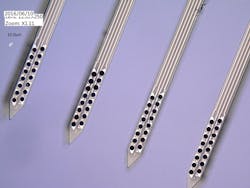Biomedical engineers at Lawrence Livermore National Laboratory teamed with researchers from the University of California, San Francisco (UCSF), to build a sensor network that records brain activity. It uses high-density implantable sensors to collect real-time data over relatively long periods of time and across several areas of the brain.
The network can continuously measure activity in nearly 400 single neurons over a period of at least five months from devices distributed in several regions of rodent brains. Using an automated spike sorter developed at UCSF, the researchers concluded the recordings are stable enough to track large numbers of individual neurons for more than a week. The research spring from a project aimed at better understanding the mechanisms of learning that occur over time.
“Being able to record from several regions for long periods of time with high fidelity lets you look at patterns of learning and how memory changes over time,” says LLNL researcher Angela Tooker. “ Now we can see what is changing from day to day in response to training, retraining, and new stimuli. It opens up a whole new field.”
Using flexible multielectrode arrays designed and developed at Lawrence Livermore National Laboratory, a team of researchers at UCSF led by Professor Loren Frank (center) was able to continuously measure the neural activity of nearly 400 single neurons over a period of at least five months from multiple regions of rodent brains. (Courtesy: Noah Berger/UCSF)
UCSF scientists implanted the polymer probes in four distant regions of a rodent’s brain: the hippocampus, ventral striatum, orbitofrontal cortex, and medial prefrontal cortex. Recordings showed how hippocampal sharp-wave ripples, which play a role in memory, also activate the orbitofrontal cortex, the medial pre-frontal cortex, and nucleus accumbens.
Researchers say the network represents a “substantial advance” over previous technologies. Its main advantage is that it lasts longer in the brain than most high-density silicon-based devices. Important activity in the brain doesn’t occur in just one place; it happens across many connected areas. As a result, scientist need to understand how different parts of the brain interact—how they talk with one another.
The multi-electrode sensors were fabricated at LLNL and combined with electrical hardware built by private neuroscience tool manufacturer SpikeGadgets. The arrays are biocompatible and flexible, so they can be safely implanted and move with the brain, reducing damage to neural tissue. Each of the 16 probes has 64 electrodes, for a total of 1,024 channels. Theoretically, each channel could record one neuron apiece, depending on where they’re positioned in the brain.
Developed in collaboration with the University of California, San Francisco, LLNL’s high-density, flexible polymer neural probes are being used by researchers to record brain activity across multiple areas of the brain at longer timescales than previously possible.
With a simple algorithm called Mountain Sort, the UCSF team tracked more than 2,000 neurons for at least an entire day, and about 21% of the neurons were tracked for more than a week. This capability would let scientists monitor changes over longer timescales, potentially making it possible to understand how the brain processes information that can take days, weeks, or even months (such as forming, consolidating, and retaining memories).
The team is now adapting the arrays to work in primates. They are also developing multi-mode arrays, adding electrical stimulation capabilities, along with optical stimulation and chemical sensing. They also want to increase the sensors’ electrode density so they can monitor more neurons.



